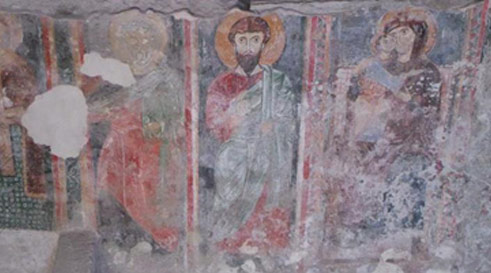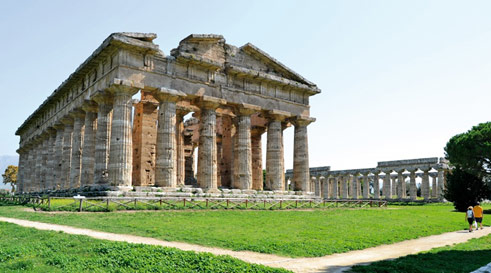Visit Salerno and Campania

Arechi Castle
The Arechi Castle is a medieval castle, situated at a height of about 300 meters above sea level, overlooking the city and the Gulf of Salerno and hosting a Museum, which shows local archeological finds.
More Information
St. Matthew Cathedral
The St. Matthew Cathedral dates to March 1084. The courtyard is surrounded by a covered walkway, supported by twenty-eight plain columns and arches, and a series of Roman tombs are along the walls. On the southern side of the cathedral the bell tower, which dates to XII century, stands.
More Information
Monumental Complex of San Pietro a Corte
The Monumental Complex of San Pietro a Corte is the most important Longobard construction in Salerno. The monumental remains represent the main architectural emergences of Medieval Salerno. As regard Longobard architecture in Europe, they are the only example of a Palace building complex. It was the most prestigious seat of the Longobard Court in Campania.
More Information
Maritime Terminal by Zaha Hadid
Described by Zaha Hadid Architects as being "like an oyster", the Salerno Maritime Terminal features an undulating concrete outer shell and an interior formed of gently sloping ramps.
More Information
Minerva Garden
The Garden of Minerva was created in the 18th century by Dr. Silvatico of the famous Medical School of Salerno, the oldest university of medicine in the world. The Garden was conceived as an educational area where doctors could teach students to recognize the plants used to treat diseases. Dr. Silvatico enriched the Garden with rare and exotic species discovered during his many travels.
More Information
Archaeological Park of Paestum
The Archaeological Park of Paestum is a UNESCO World Heritage Site. Paestum was one of the major ancient Greek cities on the coast of the Tyrrhenian Sea in Magna Graecia. Three magnificent Doric temples overlook the whole park. A Museum preserves stunning archeological finds, such as the Tomb of the Diver.
More Information
Amalfi Coast
The Amalfi Coast is a natural paradise and it is one of the fifty Italian places declared by UNESCO as a “World Heritage site”. The coast can be compared to a balcony overlooking the Tyrrhenian sea. Over the years many famous painters have tried to capture the coast’s beauty and splendor, but its allure can only be appreciated in person. The coast begins from Vietri sul Mare and ends in Positano. From the Amalfi Coast you can reach the famous islands of Capri, Ischia and other little gems.
More Information
Duomo of Amalfi
The Duomo of Amalfi is one of the most famous historical buildings of the area. The Duomo of Amalfi is located right at the center of the town, a few meters far from Municipio Square. The Duomo of Amalfi is a very peculiar architectural project: it’s composed by two basilicas, a crypt, the world-wide famous stairs, and a cloister. The cathedral is sacred to Saint Andrew and from 987 is the seat of the archbishop.
More Information
Gods' Pathway: the best place for trekking
The God’s Pathway is one of the most enjoyable you will be able to walk along in the whole Europe: a wonderful walk, with the amazing landscape of the Costiera being the perfect scenario for an unforgettable day.
More InformationA brief history of Salerno
Salerno was founded in the pre-Roman age, became a Roman colony since 197 B.C., a Langobard princedom since 847 A.D., and a Norman one since 1076. It was part of the Kingdom of the Two Sicilies.
The architecture of Salerno has greatly been influenced by Langobard domination, while Naples is mostly characterized by Byzantine art.
Langobard people, which came from Scandinavia, arrived in Italy in the sixth century. Their first settlement was in the Northern part of Italy, in fact Pavia was their capital. During the successive centuries they moved South, so the dukedom of Benevento was founded and Salerno became part of it.
Nowadays, Arechi Castle overlooks Salerno and represents one of the most remarkable remains of Langobard age. It covered a key role in the defense system of the town, in fact it was the starting point of the surrounding walls that protected the town up to the seaside.
In Medieval ages Salerno welcomed some towering scientists. In fact, in the ninth century the “Schola Salernitana” was established. It has been the first medical school of the world, and in which Christian, Jewish and Arabic doctors and researchers worked together in Salerno. Only the successive foundation of the University of Naples undermined its academic supremacy, but Salerno Medical School is also remembered to be the first one that accepted women as students and lecturers.
Salerno covered an important role also in the twentieth century, especially during the Second World War, being the capital of Italy for five months, when Allies disembarked in the South of Italy.
Last update: 17th May 2019